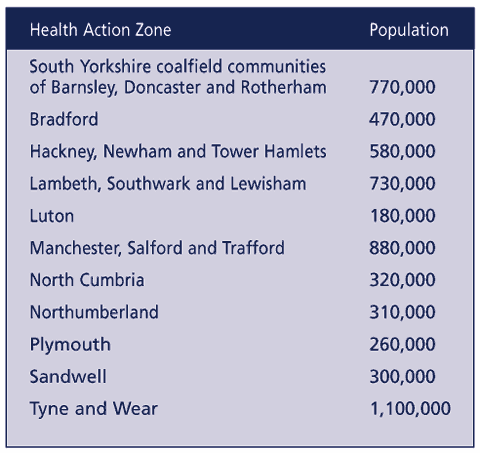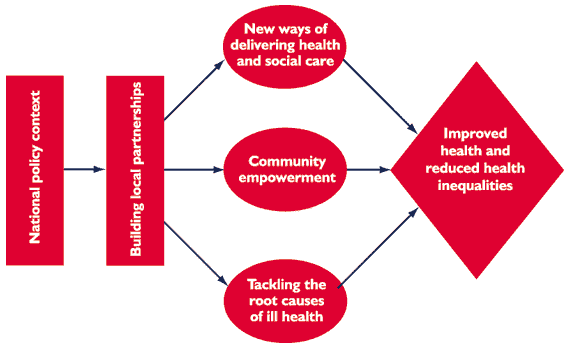 |
Close
window to return
|
Issue 2, July 1998, pp.10-11.
Health
Action Zones
Linda Bauld and Ken Judge
What are Health
Action Zones?
Health Action Zones (HAZs) are new kinds of partnerships established in
England to pioneer creative approaches to modernising services and responding
to social exclusion. The first wave of eleven HAZs began life in April
1998. Their aim is to bring together a multiplicity of public, private
and voluntary organisations to reshape local health and social services
and to improve the health of their local populations, especially those
who are most disadvantaged. The eleven areas (see Table 1) share common
problems of deprivation, social exclusion and evidence of health inequalities.
They show diversity, however, in their existing partnership arrangements
and vary fundamentally in their scale and complexity.
There are four main 'types' of HAZs:
- the most complex HAZs are those linking multiple local authorities and health agencies such as Tyne-and-Wear;
- then there are HAZs such as City & East London based on a single health authority that encompasses a number of local authorities;
- in many ways, the least complex HAZs in organisational terms are those built on a partnership between a single health authority and a single local authority such as Bradford;
- finally, there are HAZs being developed in new unitary local authorities such as Plymouth that form only part of the local health authority.
Table 1

While there is considerable
uncertainty about detailed HAZ plans, it is apparent that the eleven HAZs
are addressing the challenge in a complex variety of ways. Nevertheless,
they all share the general aims illustrated in Figure 1.
The starting point for Health Action Zones is the complex raft of national
policy initiatives launched since the May 1997 election. These include
The New NHS and Our Healthier Nation, welfare reform and welfare-to-work,
regeneration, education action zones and many others. HAZs will be expected
to respond in innovative ways to these new initiatives. At the local level,
the essence of HAZs is that the partnerships they build should be trailblazers
for new approaches to holistic government. HAZs have three immediate goals:
- to reshape health and social services;
- to empower local communities;
- to facilitate user participation and to tackle the root causes of ill health.
This approach is expected
to produce significant health gain and to reduce inequalities in health.
To achieve these ambitious aims, HAZs are developing in a wide variety
of ways. In this short piece, we highlight some of the developments which
are directly related to health inequalities.
Tackling the root causes of ill health
Our Healthier Nation identifies the wide range of factors that
impact on health. If Health Action Zones are to tackle health inequalities,
they cannot avoid developing strategies that address the causes of health
problems, including poverty, unemployment and social exclusion. But HAZs
also need to create opportunities for healthy lifestyles by expanding
access to health information and access to services and programmes which
facilitate healthy behaviours. Four key examples are: healthy food at
affordable prices; the development of Healthy Living Centres; 'healthy
schools' initiatives; and access to health information, particularly using
information technology and through the media.
The successful HAZs have already begun to think in imaginative ways about
how to take forward these two agendas. For example, a number of bids identify
school exclusion and bullying within schools as priority areas. Others
plan to use the New Deal to increase the employment of specific disadvantaged
groups, either through their own participation or by encouraging local
businesses to get involved.
The eleven successful HAZs detail specific problems related to health
which they wish to tackle, or specific groups within the community whose
health will be addressed by specific initiatives. Several HAZs focus on
improving access to mental health service for ethnic minority groups.
For example, Manchester, Salford and Trafford intend to address the problems
of young African Caribbean men in the Moss Side area of Manchester.
Figure1:
A model of Health Action Zones

There is also a widespread focus on improving young people's health. East
London, for instance, has initiatives related to anti-smoking, anti-bullying,
substance misuse and sexual health measures, among others. Lambeth, Southwark
and Lewisham also very much centre their HAZ bid around improving the
health of young people, incorporating a focus on babies and children and
including initiatives to develop parenting skills and to encourage breast
feeding.
Improving access to services is another recurrent theme. Generally, the
Primary Care Groups are seen as key, as is the expansion of IT services
to allow public access. Integrated care management and assessment arrangements
across agencies is highlighted in Northumberland's approach. Access is
also linked to community empowerment, with involvement and development
being mentioned in all the bids.
Targets and Goals
The ultimate aim of Health Action Zones is to improve the health of their
population and to reduce health in equalities. Achieving changes in health
status will take a long time, but it will be important for each HAZ to
monitor progress. For example, The New NHS White Paper states that:
'An early task for each Health Action Zone will be to develop clear targets, agreed with the NHS Executive, for measurable improvements each year.'(l)
At present, there is some uncertainty about the initial focus of the HAZ
programmes because detailed plans for each of the HAZs will not be finalised
until Autumn 1998. Nevertheless, the broad thrust of what is intended
can be identified.
Most areas intend to set targets to reduce mortality and morbidity rates.
For example, by the end of the first 7 years of HAZ status, Tyne and Wear
aspires to have improved life expectancy so that it is in the top 10 per
cent in Europe. Other HAZs focus on specific reductions in health inequalities.
For example, targets have been set to reduce the number of children living
in damp and cold housing, the number of homeless people sleeping rough,
the number of wards with more than 25 per cent of families living in poverty,
the percentage of the population who are unemployed, the extent of domestic
violence and the level of crime.
Specific conditions that HAZs intend to address include reducing rates
of coronary heart disease and cancer, reducing teenage pregnancies, tackling
diabetes, improving dental health and preventing substance misuse. For
example, Bradford has a set of objectives related to reducing diabetes,
to be achieved by a range of means including setting up 15 diabetic centres
in existing primary care facilities. East London aims particularly to
reduce the incidence of cardio-vascular disease by preventative means
such as: health promotion; increasing opportunities for physical activity;
and improving primary care and hospital based services to treat the disease.
Conclusion
It is clear that Health Action Zones do not lack ambition in the goals
that they have set for themselves. Whatever the final shape of the HAZ
programmes, there can be no doubt that collectively they represent an
important part of the Blair government's attack on social exclusion. But
achieving enduring success will require continuing effort, imagination
and a recognition on the part of central government that challenges must
be combined with genuine support and encouragement well beyond the next
general election.
References:
1. Secretary of State for Health (1997) The New NHS, London : The
Stationery Office.